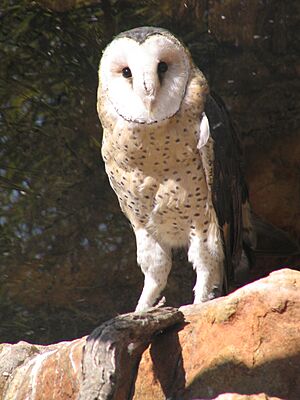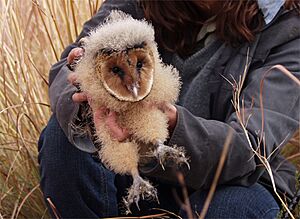African grass owl facts for kids
Quick facts for kids African grass owl |
|
|---|---|
 |
|
| Conservation status | |
| Scientific classification |
The African grass owl (Tyto capensis) is a special type of owl. It belongs to the barn owl family, called Tytonidae. These owls are mostly found in parts of Africa, living in grassy areas. They are known for their unique hunting style and how they build their nests.
Contents
What Does It Look Like?
The African grass owl looks a lot like the famous barn owl. It has a heart-shaped face that is whitish-cream. This face has a thin yellowish-brown edge with dark spots. Its eyes are dark brown, and its beak is light-colored.
The top part of its body, from its head to its back and wings, is a dark, sooty brownish-black. It has small white spots and greyish marks. Its main flight feathers are pale brownish-grey with dark stripes. The short tail feathers are brown, fading to lighter, almost white, at the ends. These outer feathers have about four dark stripes.
The owl's belly and chest can be whitish or buff, with dark spots. Its legs have whitish feathers that cover most of them. The lower legs and feet are slightly bristly and light yellowish-grey.
These owls are about 38 to 42 centimeters (15 to 17 inches) long. Their wings can be 283 to 345 millimeters (11 to 13.5 inches) long. They usually weigh between 355 and 520 grams (12.5 to 18 ounces). Female owls are often bigger and heavier than males. This difference helps them hunt and care for their young more effectively.
Its Voice
The African grass owl makes a screeching sound. It is similar to the Barn Owl's call, but not as harsh. Males are thought to sing a high-pitched, shaky sound that lasts one to two seconds.
Where Do African Grass Owls Live?
African grass owls live in many parts of Africa south of the Sahara Desert. Their main homes are in two large areas. One is in central southern Africa, from Congo and Angola to Mozambique's coast. The other is in South Africa, reaching north to parts of Zimbabwe, Botswana, and Mozambique.
You can also find smaller groups of these owls in places like the Ethiopian Highlands, Kenya, Uganda, and Cameroon.
What Kind of Home Do They Like?
The African grass owl prefers moist grasslands and open savannas. They can live in areas up to 3,200 meters (10,500 feet) high. In East Africa, they might also live in dry grasslands and higher mountains.
In southern Africa, they often choose marshes and "vleis" (wetlands). These areas have tall, thick grass and other plants. They can also be found in "fynbos" (shrubland), "renosterveld" (another type of shrubland), and "acacia" (thorny tree) areas near water. Because they need very specific types of places to live, they are known as "habitat specialists."
How Do They Live?
The African grass owl is a nocturnal animal, meaning it is active at night. You will rarely see it flying during the day. During the day, it rests on the ground in tall, thick grass. It builds special domed platforms and tunnels by flattening the grass around it. These tunnels can be several meters long and connect to other tunnels. The domed platform at the end of a tunnel is used as a nest or a resting spot during the day.
Owl pairs often rest together. Sometimes, small groups of owls might even rest close to each other. They become active after sunset and hunt throughout the night. They will only fly during the early morning or late afternoon if they cannot find enough food. Studies show that African grass owls hunt later in the morning and earlier in the evening compared to Barn owls.
What Do They Eat?
African grass owls mostly eat rodents and other small mammals. These prey animals usually weigh less than 100 grams (3.5 ounces). They catch their food from the ground. The owl usually hunts by flying close to the ground in a zigzag pattern, listening and watching for prey. It might also "sit and wait" for prey from a perch.
When an owl finds prey, it dives to the ground and picks it up with its sharp claws. It then eats the prey on the ground or takes it to a nearby resting spot. In southern Africa, they eat animals like golden moles, marsh rats, mole-rats, vlei rats, multimammate mice, hedgehogs, elephant shrews, hares, and bats. They also eat frogs, African snipe (a type of bird), and termites. In Cameroon, their diet mainly includes shrews, while in other areas, they mostly eat rodents.
Raising Their Young
African grass owls breed from December to August, but the main breeding time is from February to April. Their nest is a shallow hollow lined with grass. It is built at the end of one of their grass tunnels. The female lays two to four white eggs, usually two days apart.
Only the female owl sits on the eggs to keep them warm. This is called incubation. The male owl brings her food during this time. The female starts incubating as soon as the first egg is laid. This lasts for 32 to 42 days.
The female feeds the young chicks using food brought by the male for the first 10 days. After that, both parents feed the chicks. When the chicks are about four weeks old, the female starts to rest away from the nest. At about seven weeks old, the young owls begin to fly for the first time. Once they can fly, they stay with their parents for about three more weeks before becoming independent. Parents often remove the heads of prey before feeding them to their young.
Sometimes, African marsh harriers (another type of bird) have been seen hunting African grass owls.
Different Types of African Grass Owls
Some experts believe that the African grass owl is the same species as the eastern grass owl found in Asia and Australia. However, most scientists recognize two different types, or subspecies, of African grass owl:
- Tyto capensis cameroonensis: This subspecies lives in the Cameroon Highlands.
- Tyto capensis capensis: This subspecies lives in the rest of the African grass owl's range.
How Are They Doing?
The African grass owl is currently listed as "Least Concern" by conservation groups. This means they are not in immediate danger of disappearing globally.
However, in South Africa, the species is considered "vulnerable." This is because their homes are being damaged by farming, grazing animals, draining wetlands, and fires. The number of African grass owls in South Africa is thought to be fewer than 5,000.
The places where these owls live and hunt are often near human activities like factories, farms, or mines. This means the owls can be exposed to pollution, like metals. Scientists can study the owls' feathers to check for these pollutants. This makes the African grass owl a good "bioindicator species," meaning it helps us understand the health of the environment.
To help the vulnerable owls in South Africa, programs have tried breeding them in captivity and releasing them into the wild. Studies show this could be a good way to help them. However, releasing them is not easy. They need extra food, and the new habitat must be suitable with enough prey for them to survive.



